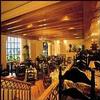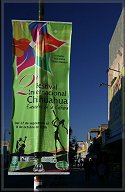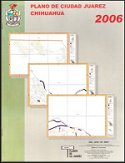History Museum - Juarez, Mexico
Don’t miss the Museum of History while in Juarez, Mexico. To get to the museum simply walk south on Avenida Juarez until you get to Ave. 16 de Septiembre. You will not be able to miss the building pictured here. (You might wish to read the information on the history of the building itself on the Historical Walking Tour. It was here that the treaties ending the Mexican Revolution were signed.)
My visit to the History Museum on March 15, 2003 was a long anticipated one. The museum had been closed for two years for renovation. Many thanks to museum official Roberto Fernández, who gave me a tour of the museum himself. Completed in 1964, the museum was designed by architect Pedro Ramírez Vázquez to present a good picture of the many cultures of pre-Hispanic Mexico.
The first room you will see is the Central Hall. Two years before his overthrow, in October, 1909 Presidente Diaz hosted a ball in this room for U.S. President Taft. It was the first time a U.S. and Mexican president had ever met. The museum has preserved a piece of the original flooring from that time.
On the day of my visit the museum had on display a reproduction of “The Shootings of May 3, 1808” by the famous Spanish Master Francisco Goya (1746-1828). Known as the “Father of Modern Art”, Goya was a leader of Romanticism and changed the way artists saw and depicted the world for centuries to come. No doubt, an art purest might find any reproduction a poor substitute for the original, but standing before this painting gave me a good idea of the grand scale on which Goya worked and encouraged me to do some research into his life.
When Goya was young he was eager to take life at face value and enjoy it. He became the Court Painter for Charles IV in 1799, and, it is said, enjoyed many love affairs with the well-to-do women of Madrid. But in his later life, he became more critical and began to question many aspects of European life of that era, particularly the cruelties of war he witnessed first hand during the French invasion of Spain. Entire books have been written about Goya’s “Black Paintings”, among which the one shown here was the first. War paintings from previous eras tended to center around a hero shown in triumph or defeat upon the battlefield and lend an aura of glory to the scene. Goya, however, in painting “The Shootings of May 3, 1808” (1814) wanted to show that often there is no noble purpose to the killings of the defeated by the victors.
Another reproduction on display was “Las Meninas (Maids of Honor)”, painted in 1656-57 by Diego Rodríguez de Silva y Velázquez (1599-1660). Some have called this painting shown his masterpiece. As a court painter, Velázquez had an incredible talent to seize upon daily scenes from royal life and capture their essential features on
canvas with seemingly little effort. It has been said that his figures seem to actually breath and that “even the dogs he paints” have life.
The figure of the artist in the left side of the painting is a self-portrait, and the two figures in the mirror behind him are the king and queen, who are the actual subjects for the sitting in this scene. So, in “Las Meninas” we see what they see, the painter standing in front of them in his studio having been interrupted by a visit by their daughter the Infanta Margarita accompanied by her maids of honor, one whom is serving her as the other curtsies to the king and queen. So the painting is not merely a technical feat but extraordinarily clever in its inception.
The musuem also has a collection of artifacts from the era of Spanish domination in Mexico.
The History Museum is a great way to while away a couple of hours when in downtown Ciudad Juarez. I hope you will visit should you make the trip.
Location: Ave. Juarez at Ave. 16 de Septiembre
10 a.m. – 5 p.m., Tuesday – Sunday




